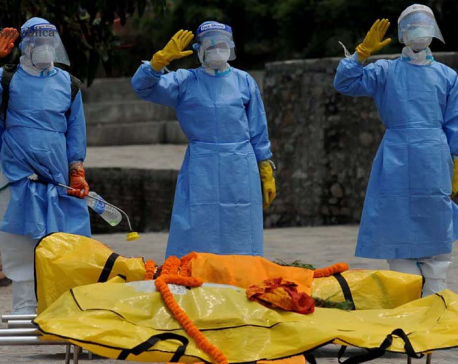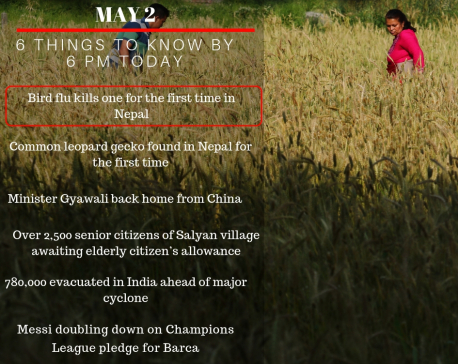
OR
Nepal sees first bird flu death
Published On: May 3, 2019 06:00 AM NPT By: Republica | @RepublicaNepal

KATHMANDU, May 2: For the first time, a man has died of avian influenza (bird flu) in Nepal.
Bird flu is caused by the highly pathogenic avian influenza A (H5N1) virus or other non-human influenza sub-types (eg H7, H9), according to the World Health Organization (WHO).
Officials at the Ministry of Health and Population (MoHP) confirmed on Thursday that a 21-year-old man died of the influenza. “The incident was unexpected,” said Dr Pushpa Chaudhari, secretary at MoHP.
However, the ministry did not disclose details about the dead man although he was reported to be from Kavre district. According to MoHP, the man reached the hospital on March 24. His saliva sample was sent to the National Public Health Laboratory. He was given anti-influenza medicine on March 25 but he died on March 29 of respiratory problems. The lab test in Nepal could not detect the bird flu. But the sample was sent to Japan and a report was received from there on April confirming the sample positive for H5N1 .
According to WHO, avian influenza was detected in 1996 and 454 out of 860 infected people have died of the infection since 2003. WHO advises on avian influenza as follows:
Transmission
Human infections with highly pathogenic avian influenza A (H5N1) virus occur through bird-to-human, possibly environment-to-human and, very rarely, limited, non-sustained human-to-human transmission. Direct contact or exposure with infected poultry, or with surfaces and objects contaminated by their droppings, is the main route of transmission to humans. There is no evidence that properly cooked poultry or poultry products can be a source of infection.
Nature of the disease
Patients usually present initial symptoms of fever and influenza-like illness (malaise, myalgia, cough, sore throat). Diarrhea and other gastrointestinal symptoms may occur. The disease progresses within days and many patients develop clinically apparent pneumonia with radiographic infiltrates of varying patterns. Sputum production is variable and sometimes bloody. Multi-organ failure, sepsis-like syndromes and, uncommonly, encephalopathy occur. The fatality rate among hospitalized patients with confirmed H5N1 infection has been high (about 60%), most commonly as a result of respiratory failure caused by progressive pneumonia and acute respiratory distress syndrome.
Fatal outcome had also been reported for H7N7 infection in humans. However, other avian influenza subtypes (eg H9N2) appear to cause mild diseases.Geographical distributionExtensive outbreaks in poultry have occurred in parts of Africa, Asia, Europe and the Middle East since 1997, but only sporadic human infections have occurred to date. Continued exposure of humans to avian H5N1 viruses increases the likelihood that the virus will acquire the necessary characteristics for efficient and sustained human-to-human transmission through either gradual genetic mutation or reassortment with a human influenza A virus. Between November 2003 and July 2008, nearly 400 human cases of laboratory-confirmed H5N1 infection were reported to WHO from 15 countries in Africa, south-east and central Asia, Europe and the Middle East.
Risk for travelersH5N1 avian influenza is primarily a disease of birds. The virus does not easily cross the species barrier to infect humans. To date, no traveler is known to have been infected.ProphylaxisNeuraminidase inhibitors (oseltamivir, zanamivir) are inhibitory for the virus and have proven efficacy in vitro and in animal studies for prophylaxis and treatment of H5N1 infection. Studies in hospitalized H5N1 patients, although limited, suggest that early treatment with oseltamivir improves survival. Late intervention with oseltamivir is also justified. Neuraminidase inhibitors are recommended for post-exposure prophylaxis in certain exposed individuals. At present WHO does not recommend pre-exposure prophylaxis for travelers but advice may change depending on new findings. Inactivated H5N1 vaccines for human use have been developed and licensed in several countries but are not yet generally available; however, this situation is expected to change.
Precautions
In affected countries, people or travelers should avoid contact with high-risk environments such as live animal markets and poultry farms, any free-ranging or caged poultry, or surfaces that might be contaminated by poultry droppings. People or travelers in affected countries should avoid contact with dead migratory birds or wild birds showing signs of disease, and should avoid consumption of undercooked eggs, poultry or poultry products. Hand hygiene with frequent washing or use of alcohol rubs is recommended. If exposure to individuals with suspected H5N1 illness or severe, unexplained respiratory illness occurs, travelers should urgently consult health professionals. Travelers should contact their local health providers or national health authorities for supplementary information.
You May Like This

3 members of a family die of COVID-19 after attending a wedding
Baglung, May 14: As many as three members of a family have died of COVID-19 within a week from Badigad... Read More...

May 2: 6 things to know by 6 PM today
Your daily dose of missed important news of the day. ... Read More...

Woman, son found dead
RUKUM, Jan 13: A woman and her 20-month-old son were found dead in a forest at Sisne Rural Municipality-6 in... Read More...







Just In
- First meeting of Nepal-China aid projects concludes
- Lungeli appointed as Minister for Labor and Transport in Madhesh province govt
- Bus knocks down a pilgrim to death in Chitwan
- One killed in tractor-hit
- Karnali Chief Minister Kandel to seek vote of confidence today
- Chain for Change organizes ‘Project Wings to Dreams’ orientation event for inclusive education
- Gold price decreases by Rs 200 per tola today
- National Development Council meeting underway












Leave A Comment